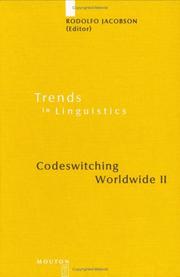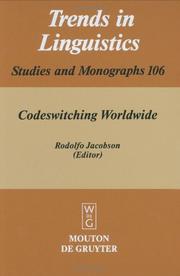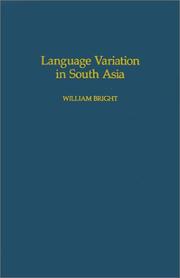| Listing 1 - 10 of 94 | << page >> |
Sort by
|
Book
ISBN: 9027237492 1556192533 9786613312945 1283312948 9027276919 9789027276919 9789027237491 9781556192531 Year: 1993 Publisher: Amsterdam Benjamins
Abstract | Keywords | Export | Availability | Bookmark
 Loading...
Loading...Choose an application
- Reference Manager
- EndNote
- RefWorks (Direct export to RefWorks)
Today, the notion of 'diglossia' occupies a prominent place in sociolinguistic research. Since the 1960s, when the dominant sense of 'diglossia' was the complementary sociofunctional distribution of two varieties of the same language, the term has been applied - often controversially - to a growing number of diverse sociolinguistic situations. As a consequence of this extension of the scope of the concept, in combination with an increasing interest in the relationship between the role of language and the social structure, the number of publications in this field has risen exponentially over th
Sociolinguistics --- Diglossia (Linguistics) --- Language shift --- Linguistics --- Code switching (Linguistics)

ISBN: 3110808749 9783110808742 3110167689 9783110167689 Year: 2001 Volume: 126 Publisher: Berlin New York Mouton de Gruyter
Abstract | Keywords | Export | Availability | Bookmark
 Loading...
Loading...Choose an application
- Reference Manager
- EndNote
- RefWorks (Direct export to RefWorks)
No detailed description available for "CODESWITCHING WORLDWIDE 2 (JACOBSON) TILSM 126 E-BOOK".
Code switching (Linguistics) --- Language shift --- Switching (Linguistics) --- Bilingualism --- Linguistics --- Diglossia (Linguistics) --- Script switching (Linguistics)
Book
ISBN: 1315401088 131540110X 1315401096 1138225053 1138225061 Year: 2019 Publisher: Florence : Routledge,
Abstract | Keywords | Export | Availability | Bookmark
 Loading...
Loading...Choose an application
- Reference Manager
- EndNote
- RefWorks (Direct export to RefWorks)
Bringing together sociolinguistic, linguistic, and educational perspectives, this cuttingedge overview of codeswitching examines language mixing in teaching and learning in bilingual classrooms. As interest in pedagogical applications of bilingual language mixing increases, so too does a need for a thorough discussion of the topic. This volume serves that need by providing an original and wide-ranging discussion of theoretical, pedagogical, and policyrelated issues and obstacles in classroom settings--the pedagogical consequences of codeswitching for teaching and learning of language and content in oneway and twoway bilingual classrooms. Part I provides an introduction to (socio)linguistic and pedagogical contributions to scholarship in the field, both historical and contemporary. Part II focuses on codeswitching in teaching and learning, and addresses a range of pedagogical challenges to language mixing in a variety of contexts, such as literacy and mathematics instruction. Part III looks at language ideology and language policy to explore how students navigate educational spaces and negotiate their identities in the face of competing language ideologies and assumptions. This volume breaks new ground and serves as an important contribution on codeswitching for scholars, researchers, and teacher educators of language education, multilingualism, and applied linguistics.
Code switching (Linguistics) --- Language shift --- Switching (Linguistics) --- Bilingualism --- Linguistics --- Diglossia (Linguistics) --- Script switching (Linguistics)
Book
ISBN: 2892192242 Year: 1991 Publisher: Québec : Centre international de recherche en aménagement linguistique,
Abstract | Keywords | Export | Availability | Bookmark
 Loading...
Loading...Choose an application
- Reference Manager
- EndNote
- RefWorks (Direct export to RefWorks)
Code switching (Linguistics) --- -Language shift --- Switching (Linguistics) --- Bilingualism --- Linguistics --- Diglossia (Linguistics) --- -Code switching (Linguistics) --- Italians --- Languages in contact --- Multilingualism --- Plurilingualism --- Polyglottism --- Language shift --- Language --- Ethnology --- Language and languages --- Areal linguistics --- Script switching (Linguistics) --- Québec (canada, province) --- Sociolinguistique --- Langues
Book
ISBN: 9027930686 Year: 1980 Publisher: The Hague Mouton
Abstract | Keywords | Export | Availability | Bookmark
 Loading...
Loading...Choose an application
- Reference Manager
- EndNote
- RefWorks (Direct export to RefWorks)
Sociolinguistics --- Bilingualism --- Diglossia (Linguistics) --- Language shift --- Linguistics --- Code switching (Linguistics) --- Language and languages --- Languages in contact --- Multilingualism --- Bilingualism. --- Diglossia (Linguistics).


ISBN: 3110151510 3110812193 9783110812190 9783110151510 Year: 2011 Volume: 106 Publisher: Berlin Boston
Abstract | Keywords | Export | Availability | Bookmark
 Loading...
Loading...Choose an application
- Reference Manager
- EndNote
- RefWorks (Direct export to RefWorks)
No detailed description available for "CODESWITCHING WORLDWIDE 1 (JACOBSON) TILSM 106 E-BOOK".
Code switching (Linguistics) --- Bilingualism --- Changement de code (Linguistique) --- Bilinguisme --- Language shift --- Switching (Linguistics) --- Linguistics --- Diglossia (Linguistics) --- Script switching (Linguistics)
Book
ISBN: 1788926684 1788926676 Year: 2019 Publisher: Blue Ridge Summit, PA : Multilingual Matters,
Abstract | Keywords | Export | Availability | Bookmark
 Loading...
Loading...Choose an application
- Reference Manager
- EndNote
- RefWorks (Direct export to RefWorks)
This volume addresses the question ‘What role does religion play in the maintenance, revival and/or shift, of languages?’ The chapters in this volume explore the complex and dynamic relationship between religion and the maintenance, revival and/or shift of languages in different multilingual multicultural contexts, under diverse sociopolitical conditions, at different points in time. The 12 chapters cover data from Algeria, India, Israel, Malaysia, Nigeria, Singapore, UK, USA and Uganda and discuss the impact of context, ideology, identity and education on the following religions: Buddhism, Christianity, Hinduism, Islam, Judaism, Sikhism, and some religions closely associated with China such as Confucianism and Taoism, and their respective languages and varieties of language in these regions. The languages discussed by the writers in this volume include Arabic, English, Hebrew, Malay, Mandarin, Portuguese, Punjabi, Pali, Sanskrit, Tamazight and Yoruba.
Book
ISBN: 9789027201447 9027201447 9789027263544 902726354X Year: 2018 Publisher: Amsterdam Philadelphia
Abstract | Keywords | Export | Availability | Bookmark
 Loading...
Loading...Choose an application
- Reference Manager
- EndNote
- RefWorks (Direct export to RefWorks)
This volume compiles eight original chapters dedicated to different topics within bilingual grammar and processing with special focus on code-switching. Three main features unify the contributions to this volume. First, they focus on making a contribution to our understanding of the human language within a coherent theoretical framework; second, they understand that a complete theory of the human language needs to include data from bilinguals’ I-languages; and third, they are committed to obtaining reliable data following experimental protocols.
Bilingualism. --- Code switching (Linguistics). --- Code switching (Linguistics) --- Bilingualism --- Language and languages --- Languages in contact --- Multilingualism --- Language shift --- Switching (Linguistics) --- Linguistics --- Diglossia (Linguistics) --- E-books --- Script switching (Linguistics)

ISBN: 1280605464 0195362497 9780195362497 0195063651 9780195063653 019772194X Year: 1990 Publisher: New York Oxford University Press
Abstract | Keywords | Export | Availability | Bookmark
 Loading...
Loading...Choose an application
- Reference Manager
- EndNote
- RefWorks (Direct export to RefWorks)
This volume contains 12 essays on the languages of South Asia, written by a leading authority on the subject.
Dravidian languages --- Diglossia (Linguistics) --- Language shift --- Linguistics --- Sociolinguistics --- Code switching (Linguistics) --- Variation. --- South Asia --- Asia, South --- Asia, Southern --- Indian Sub-continent --- Indian Subcontinent --- Southern Asia --- Orient --- Languages
Book
ISBN: 1282245309 9786612245305 902728928X 9789027289285 9789027241788 9027241783 Year: 2009 Publisher: Amsterdam Philadelphia John Benjamins Pub.
Abstract | Keywords | Export | Availability | Bookmark
 Loading...
Loading...Choose an application
- Reference Manager
- EndNote
- RefWorks (Direct export to RefWorks)
The volume presents a selection of contributions by leading scholars in the field of code-switching. In the past the phenomenon of code-switching was studied within different subfields of linguistics and they all took their own perspectives on code-switching without taking into account findings from other subdisciplines. This book raises a question of a much broader multidisciplinary approach to studying the phenomenon of code-switching; calls for integration of disciplines; and illustrates how frameworks from one subfield can be applied to models in another. The volume includes survey chapters, empirical studies, contributions that use empirical data to test new hypotheses about code-switching, or suggest new approaches and models for the study of code-switching, and chapters that discuss principles and constraints of code-switching, and code-switching vs. transfer. The book is easily accessible to anyone who is interested in the phenomenon of code-switching in bilinguals.
Bilingualism. --- Code switching (Linguistics) --- Language shift --- Switching (Linguistics) --- Bilingualism --- Linguistics --- Diglossia (Linguistics) --- Language and languages --- Languages in contact --- Multilingualism --- Script switching (Linguistics)
| Listing 1 - 10 of 94 | << page >> |
Sort by
|

 Search
Search Feedback
Feedback About UniCat
About UniCat  Help
Help News
News